-
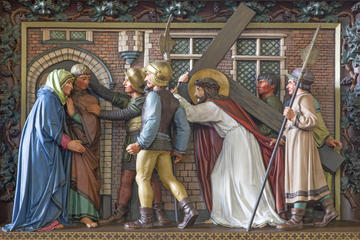 Jerusalem Church (Jeruzalemkerk)
Jerusalem Church (Jeruzalemkerk) By the 15th century, Bruges was a wealthy town; thanks to patronage by the Dukes of Burgundy and its membership of the Hanseatic League, marketeers from all over Europe had a base there and traded with the rest of northern Europe through a busy river port at what i
Jerusalem Church (Jeruzalemkerk)
Jerusalem Church (Jeruzalemkerk) By the 15th century, Bruges was a wealthy town; thanks to patronage by the Dukes of Burgundy and its membership of the Hanseatic League, marketeers from all over Europe had a base there and traded with the rest of northern Europe through a busy river port at what i
-
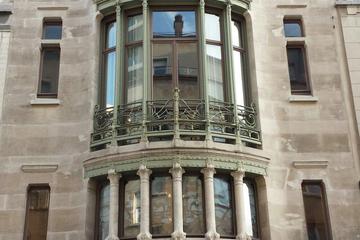 Hotel Tassel
Hotel Tassel This Brussels town house is widely considered to be the first structure built in Art Nouveau style. Designed by architect Victor Horta in 1894, it was named a UNESCO World Heritage site along with three of Horta’s other iconic hotels. Horta was a pioneer of the Art Nouveau transition
Hotel Tassel
Hotel Tassel This Brussels town house is widely considered to be the first structure built in Art Nouveau style. Designed by architect Victor Horta in 1894, it was named a UNESCO World Heritage site along with three of Horta’s other iconic hotels. Horta was a pioneer of the Art Nouveau transition
-
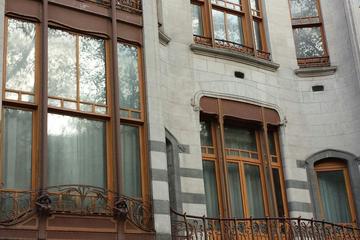 Hotel Solvay
Hotel Solvay Famous Brussels architect and leader of the Art Nouveau movement Victor Horta built this town house along Avenue Louise in 1894. Horta designed the house in great detail and with precious material from floor to ceiling. From the carpets and walls to the furniture and the light fixture
Hotel Solvay
Hotel Solvay Famous Brussels architect and leader of the Art Nouveau movement Victor Horta built this town house along Avenue Louise in 1894. Horta designed the house in great detail and with precious material from floor to ceiling. From the carpets and walls to the furniture and the light fixture
-
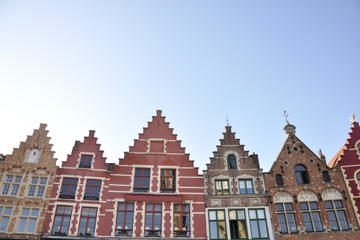 Historic Centre of Bruges
Historic Centre of Bruges Bruges is one of the most picturesque cities in Belgium. Its one of Belgiums best preserved cities, and its medieval architecture escaped destruction from both World Wars. More than 1,000 years ago, Brugge was an important trade city due to its location near the coast. Bu
Historic Centre of Bruges
Historic Centre of Bruges Bruges is one of the most picturesque cities in Belgium. Its one of Belgiums best preserved cities, and its medieval architecture escaped destruction from both World Wars. More than 1,000 years ago, Brugge was an important trade city due to its location near the coast. Bu
-
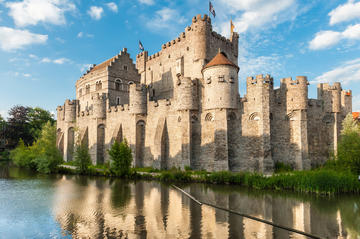 Gravensteen Castle (Castle of the Counts)
Gravensteen Castle (Castle of the Counts) Moated Gravensteen Castle is a circular, gray fortress built in 1180 alongside a split in Ghent’s River Leie to symbolize the power of Philip of Alsace, who was the ruling Count of Flanders. Although a wooden castle had existed here for centuries, the new
Gravensteen Castle (Castle of the Counts)
Gravensteen Castle (Castle of the Counts) Moated Gravensteen Castle is a circular, gray fortress built in 1180 alongside a split in Ghent’s River Leie to symbolize the power of Philip of Alsace, who was the ruling Count of Flanders. Although a wooden castle had existed here for centuries, the new
-
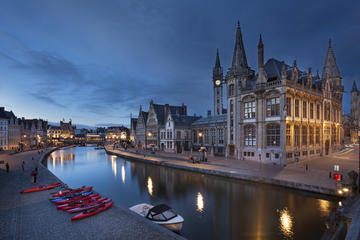 Graslei and Korenlei
Graslei and Korenlei The medieval quays of Graslei and Korenlei face each other across the canalized River Leie and originally formed part of Tusschen Brugghen, the city’s thriving harbour. Their banks are lined with a rare architectural treat – the loveliest gabled guild houses and warehouses in
Graslei and Korenlei
Graslei and Korenlei The medieval quays of Graslei and Korenlei face each other across the canalized River Leie and originally formed part of Tusschen Brugghen, the city’s thriving harbour. Their banks are lined with a rare architectural treat – the loveliest gabled guild houses and warehouses in
-
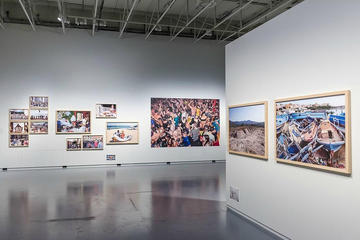 FoMu (Musee de la Photographie)
FoMu (Musee de la Photographie) Found in a former waterside warehouse in the on‐trend area of Zuid south of Antwerp city center, FoMu first opened in 1986 but moved to its current home in 2004. Its clean, white lines are perfect for presenting a series of temporary photographic exhibitions sourced
FoMu (Musee de la Photographie)
FoMu (Musee de la Photographie) Found in a former waterside warehouse in the on‐trend area of Zuid south of Antwerp city center, FoMu first opened in 1986 but moved to its current home in 2004. Its clean, white lines are perfect for presenting a series of temporary photographic exhibitions sourced
-
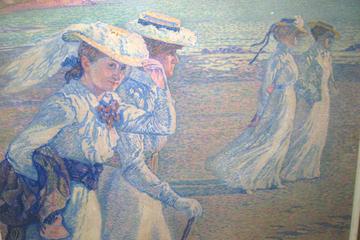 Fin-de-Siècle Museum
Fin-de-Siècle Museum One of Brussels’ newest museums, the Fin-de-Siècle celebrates the city’s history as an artistic capital at the end of the 19th century. Though a tempestuous time politically, artists emerged during this time period that pushed the envelope away from classical traditions into m
Fin-de-Siècle Museum
Fin-de-Siècle Museum One of Brussels’ newest museums, the Fin-de-Siècle celebrates the city’s history as an artistic capital at the end of the 19th century. Though a tempestuous time politically, artists emerged during this time period that pushed the envelope away from classical traditions into m
-
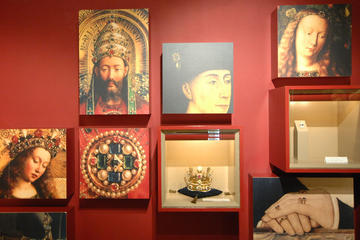 Diamond Museum
Diamond Museum Both the Belgian cities of Bruges and Antwerp feature prominently in the history of the diamond trade, and it was in Bruges that the art of diamond polishing is thought to have been invented. Around 1450, local goldsmith Lodewijk van Berquem first used the technique of polishing dia
Diamond Museum
Diamond Museum Both the Belgian cities of Bruges and Antwerp feature prominently in the history of the diamond trade, and it was in Bruges that the art of diamond polishing is thought to have been invented. Around 1450, local goldsmith Lodewijk van Berquem first used the technique of polishing dia
-
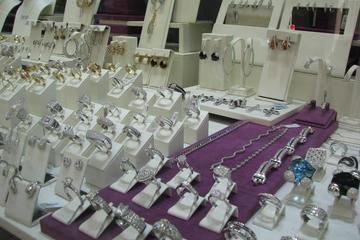 Diamond District
Diamond District About 84 percent of the world’s uncut diamonds pass through Antwerp’s Diamond Quarter, an enclave of side streets just west of Central Station. Every year more than £32 billion in polished, cut diamonds pass through the four trading exchanges, regulated by the Antwerp World Diamon
Diamond District
Diamond District About 84 percent of the world’s uncut diamonds pass through Antwerp’s Diamond Quarter, an enclave of side streets just west of Central Station. Every year more than £32 billion in polished, cut diamonds pass through the four trading exchanges, regulated by the Antwerp World Diamon
-
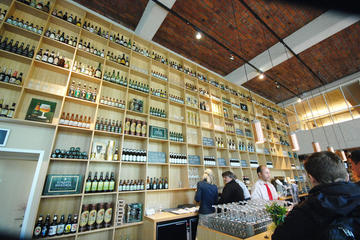 De Halve Maan Brewery
De Halve Maan Brewery Any visit to Belgium is more than likely going to involve sampling some of the local beers, and Bruges’ De Halve Maan Brewery is one of the best working breweries you can visit. De Halve Maan is the only brewery still working in Bruges’ city center. The first recorded mention
De Halve Maan Brewery
De Halve Maan Brewery Any visit to Belgium is more than likely going to involve sampling some of the local beers, and Bruges’ De Halve Maan Brewery is one of the best working breweries you can visit. De Halve Maan is the only brewery still working in Bruges’ city center. The first recorded mention
-
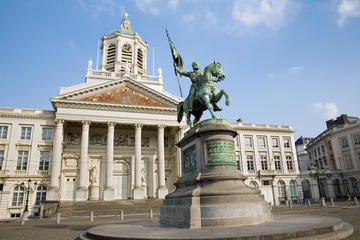 Coudenberg (Former Palace of Brussels)
Coudenberg (Former Palace of Brussels) Found at the southern end of the Parc de Bruxelles, Coudenberg marks the site of the original palace of the Belgian Royal Family, which was destroyed to make way for the present Palais Royal. In the 12th century a small, fortified castle stood on Coudenberg H
Coudenberg (Former Palace of Brussels)
Coudenberg (Former Palace of Brussels) Found at the southern end of the Parc de Bruxelles, Coudenberg marks the site of the original palace of the Belgian Royal Family, which was destroyed to make way for the present Palais Royal. In the 12th century a small, fortified castle stood on Coudenberg H
-
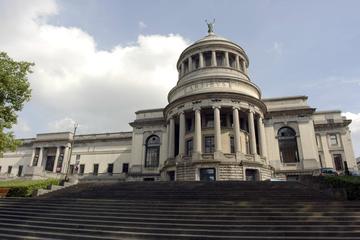 Cinquantenaire Museum
Cinquantenaire Museum Culture, art, and history abound in this Belgian national museum. The four main collections span periods of time from prehistory in national archaeology and classical antiquity, to European decorative arts and non-European displays. Explore artifacts from all over the world,
Cinquantenaire Museum
Cinquantenaire Museum Culture, art, and history abound in this Belgian national museum. The four main collections span periods of time from prehistory in national archaeology and classical antiquity, to European decorative arts and non-European displays. Explore artifacts from all over the world,
-
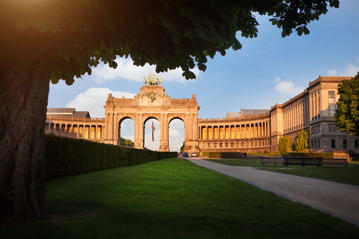 Cinquantenaire District
Cinquantenaire District The Cinquantenaire District in Brussels is the area of the city surrounding the Cinquantenaire Park. The park itself was built to commemorate 50 years of Belgiums independence. Dominating the park is the Triumphal Arch and three museums. The museums located here are Autowor
Cinquantenaire District
Cinquantenaire District The Cinquantenaire District in Brussels is the area of the city surrounding the Cinquantenaire Park. The park itself was built to commemorate 50 years of Belgiums independence. Dominating the park is the Triumphal Arch and three museums. The museums located here are Autowor
-
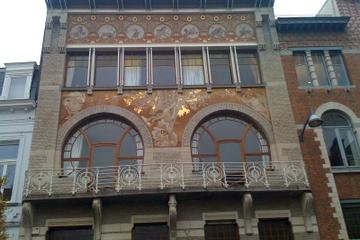 Ciamberlani House
Ciamberlani House The Ciamberlani House is a townhouse in Brussels that was built by Paul Hankar for the Italian artist Albert Ciamberlani in 1897. Hankar and Ciamberlani collaborated on the design and details of the house, and it is one of the major Art Nouveau buildings in Belgium. Architect Adr
Ciamberlani House
Ciamberlani House The Ciamberlani House is a townhouse in Brussels that was built by Paul Hankar for the Italian artist Albert Ciamberlani in 1897. Hankar and Ciamberlani collaborated on the design and details of the house, and it is one of the major Art Nouveau buildings in Belgium. Architect Adr
-
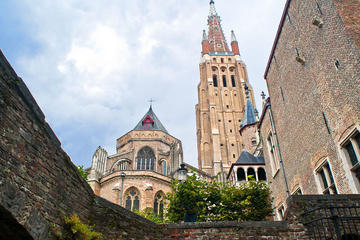 Church of Our Lady (Onze Lieve Vrouwekerk)
Church of Our Lady (Onze Lieve Vrouwekerk) The soaring 400-foot (122-meter) spire-topped brick steeple of the Church of Our Lady – the city’s tallest structure – lends itself to commanding views of Bruges. The spire dominates the Bruges skyline and can be seen from all over the city, while from in
Church of Our Lady (Onze Lieve Vrouwekerk)
Church of Our Lady (Onze Lieve Vrouwekerk) The soaring 400-foot (122-meter) spire-topped brick steeple of the Church of Our Lady – the city’s tallest structure – lends itself to commanding views of Bruges. The spire dominates the Bruges skyline and can be seen from all over the city, while from in
-
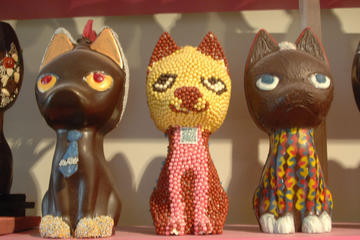 Choco Story
Choco Story A visit to the museum of chocolate, Choco Story is best reserved for only the most serious of cocoa bean aficionados. The museum’s exhibits run through centuries of the history of chocolate, from the Mayans to the present, and cover every step of the chocolate-making process, from the
Choco Story
Choco Story A visit to the museum of chocolate, Choco Story is best reserved for only the most serious of cocoa bean aficionados. The museum’s exhibits run through centuries of the history of chocolate, from the Mayans to the present, and cover every step of the chocolate-making process, from the
-
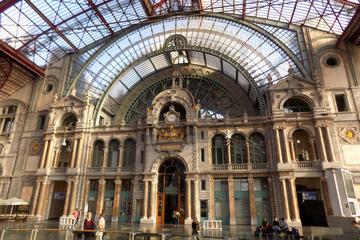 Central Station
Central Station Antwerp’s main railway station is a much-loved city landmark, a spectacular domed building of majestic proportions on Koningin Astridplain and nicknamed the Spoorwegkathedraal (Railway Cathedral) by its local fans. It was designed by Flemish architect Louis Delacenserie and was com
Central Station
Central Station Antwerp’s main railway station is a much-loved city landmark, a spectacular domed building of majestic proportions on Koningin Astridplain and nicknamed the Spoorwegkathedraal (Railway Cathedral) by its local fans. It was designed by Flemish architect Louis Delacenserie and was com
-
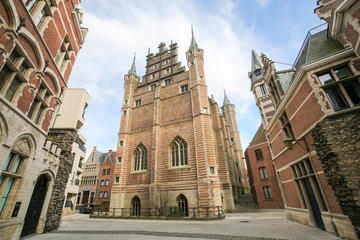 Butchers Hall (Vleeshuis)
Butchers Hall (Vleeshuis) Centered on Antwerp’s Grote Markt and the surrounding streets are some outstanding guild houses, built during the city’s 16th- and 17th-century Golden Age as trading was expanding and its citizens were getting seriously rich. Just north of the square stands the former But
Butchers Hall (Vleeshuis)
Butchers Hall (Vleeshuis) Centered on Antwerp’s Grote Markt and the surrounding streets are some outstanding guild houses, built during the city’s 16th- and 17th-century Golden Age as trading was expanding and its citizens were getting seriously rich. Just north of the square stands the former But
-
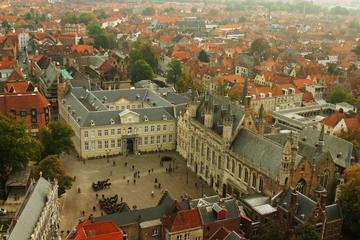 Burg Square
Burg Square The birth of the city of Bruges was heralded by Baldwin Iron Arm’s (Count of Flanders I) construction of a fortified castle on top of a hill in the 9th century. The castle was originally built to protect the area from invading Vikings and Normans and remained the seat of the Counts of
Burg Square
Burg Square The birth of the city of Bruges was heralded by Baldwin Iron Arm’s (Count of Flanders I) construction of a fortified castle on top of a hill in the 9th century. The castle was originally built to protect the area from invading Vikings and Normans and remained the seat of the Counts of
Total
660 -travel
FirstPage PreviousPage NextPage LastPage CurrentPage:
2/33 20-travel/Page GoTo Page:
 Jerusalem Church (Jeruzalemkerk)
Jerusalem Church (Jeruzalemkerk) By the 15th century, Bruges was a wealthy town; thanks to patronage by the Dukes of Burgundy and its membership of the Hanseatic League, marketeers from all over Europe had a base there and traded with the rest of northern Europe through a busy river port at what i
Jerusalem Church (Jeruzalemkerk)
Jerusalem Church (Jeruzalemkerk) By the 15th century, Bruges was a wealthy town; thanks to patronage by the Dukes of Burgundy and its membership of the Hanseatic League, marketeers from all over Europe had a base there and traded with the rest of northern Europe through a busy river port at what i
 Hotel Tassel
Hotel Tassel This Brussels town house is widely considered to be the first structure built in Art Nouveau style. Designed by architect Victor Horta in 1894, it was named a UNESCO World Heritage site along with three of Horta’s other iconic hotels. Horta was a pioneer of the Art Nouveau transition
Hotel Tassel
Hotel Tassel This Brussels town house is widely considered to be the first structure built in Art Nouveau style. Designed by architect Victor Horta in 1894, it was named a UNESCO World Heritage site along with three of Horta’s other iconic hotels. Horta was a pioneer of the Art Nouveau transition
 Hotel Solvay
Hotel Solvay Famous Brussels architect and leader of the Art Nouveau movement Victor Horta built this town house along Avenue Louise in 1894. Horta designed the house in great detail and with precious material from floor to ceiling. From the carpets and walls to the furniture and the light fixture
Hotel Solvay
Hotel Solvay Famous Brussels architect and leader of the Art Nouveau movement Victor Horta built this town house along Avenue Louise in 1894. Horta designed the house in great detail and with precious material from floor to ceiling. From the carpets and walls to the furniture and the light fixture
 Historic Centre of Bruges
Historic Centre of Bruges Bruges is one of the most picturesque cities in Belgium. Its one of Belgiums best preserved cities, and its medieval architecture escaped destruction from both World Wars. More than 1,000 years ago, Brugge was an important trade city due to its location near the coast. Bu
Historic Centre of Bruges
Historic Centre of Bruges Bruges is one of the most picturesque cities in Belgium. Its one of Belgiums best preserved cities, and its medieval architecture escaped destruction from both World Wars. More than 1,000 years ago, Brugge was an important trade city due to its location near the coast. Bu
 Gravensteen Castle (Castle of the Counts)
Gravensteen Castle (Castle of the Counts) Moated Gravensteen Castle is a circular, gray fortress built in 1180 alongside a split in Ghent’s River Leie to symbolize the power of Philip of Alsace, who was the ruling Count of Flanders. Although a wooden castle had existed here for centuries, the new
Gravensteen Castle (Castle of the Counts)
Gravensteen Castle (Castle of the Counts) Moated Gravensteen Castle is a circular, gray fortress built in 1180 alongside a split in Ghent’s River Leie to symbolize the power of Philip of Alsace, who was the ruling Count of Flanders. Although a wooden castle had existed here for centuries, the new
 Graslei and Korenlei
Graslei and Korenlei The medieval quays of Graslei and Korenlei face each other across the canalized River Leie and originally formed part of Tusschen Brugghen, the city’s thriving harbour. Their banks are lined with a rare architectural treat – the loveliest gabled guild houses and warehouses in
Graslei and Korenlei
Graslei and Korenlei The medieval quays of Graslei and Korenlei face each other across the canalized River Leie and originally formed part of Tusschen Brugghen, the city’s thriving harbour. Their banks are lined with a rare architectural treat – the loveliest gabled guild houses and warehouses in
 FoMu (Musee de la Photographie)
FoMu (Musee de la Photographie) Found in a former waterside warehouse in the on‐trend area of Zuid south of Antwerp city center, FoMu first opened in 1986 but moved to its current home in 2004. Its clean, white lines are perfect for presenting a series of temporary photographic exhibitions sourced
FoMu (Musee de la Photographie)
FoMu (Musee de la Photographie) Found in a former waterside warehouse in the on‐trend area of Zuid south of Antwerp city center, FoMu first opened in 1986 but moved to its current home in 2004. Its clean, white lines are perfect for presenting a series of temporary photographic exhibitions sourced
 Fin-de-Siècle Museum
Fin-de-Siècle Museum One of Brussels’ newest museums, the Fin-de-Siècle celebrates the city’s history as an artistic capital at the end of the 19th century. Though a tempestuous time politically, artists emerged during this time period that pushed the envelope away from classical traditions into m
Fin-de-Siècle Museum
Fin-de-Siècle Museum One of Brussels’ newest museums, the Fin-de-Siècle celebrates the city’s history as an artistic capital at the end of the 19th century. Though a tempestuous time politically, artists emerged during this time period that pushed the envelope away from classical traditions into m
 Diamond Museum
Diamond Museum Both the Belgian cities of Bruges and Antwerp feature prominently in the history of the diamond trade, and it was in Bruges that the art of diamond polishing is thought to have been invented. Around 1450, local goldsmith Lodewijk van Berquem first used the technique of polishing dia
Diamond Museum
Diamond Museum Both the Belgian cities of Bruges and Antwerp feature prominently in the history of the diamond trade, and it was in Bruges that the art of diamond polishing is thought to have been invented. Around 1450, local goldsmith Lodewijk van Berquem first used the technique of polishing dia
 Diamond District
Diamond District About 84 percent of the world’s uncut diamonds pass through Antwerp’s Diamond Quarter, an enclave of side streets just west of Central Station. Every year more than £32 billion in polished, cut diamonds pass through the four trading exchanges, regulated by the Antwerp World Diamon
Diamond District
Diamond District About 84 percent of the world’s uncut diamonds pass through Antwerp’s Diamond Quarter, an enclave of side streets just west of Central Station. Every year more than £32 billion in polished, cut diamonds pass through the four trading exchanges, regulated by the Antwerp World Diamon
 De Halve Maan Brewery
De Halve Maan Brewery Any visit to Belgium is more than likely going to involve sampling some of the local beers, and Bruges’ De Halve Maan Brewery is one of the best working breweries you can visit. De Halve Maan is the only brewery still working in Bruges’ city center. The first recorded mention
De Halve Maan Brewery
De Halve Maan Brewery Any visit to Belgium is more than likely going to involve sampling some of the local beers, and Bruges’ De Halve Maan Brewery is one of the best working breweries you can visit. De Halve Maan is the only brewery still working in Bruges’ city center. The first recorded mention
 Coudenberg (Former Palace of Brussels)
Coudenberg (Former Palace of Brussels) Found at the southern end of the Parc de Bruxelles, Coudenberg marks the site of the original palace of the Belgian Royal Family, which was destroyed to make way for the present Palais Royal. In the 12th century a small, fortified castle stood on Coudenberg H
Coudenberg (Former Palace of Brussels)
Coudenberg (Former Palace of Brussels) Found at the southern end of the Parc de Bruxelles, Coudenberg marks the site of the original palace of the Belgian Royal Family, which was destroyed to make way for the present Palais Royal. In the 12th century a small, fortified castle stood on Coudenberg H
 Cinquantenaire Museum
Cinquantenaire Museum Culture, art, and history abound in this Belgian national museum. The four main collections span periods of time from prehistory in national archaeology and classical antiquity, to European decorative arts and non-European displays. Explore artifacts from all over the world,
Cinquantenaire Museum
Cinquantenaire Museum Culture, art, and history abound in this Belgian national museum. The four main collections span periods of time from prehistory in national archaeology and classical antiquity, to European decorative arts and non-European displays. Explore artifacts from all over the world,
 Cinquantenaire District
Cinquantenaire District The Cinquantenaire District in Brussels is the area of the city surrounding the Cinquantenaire Park. The park itself was built to commemorate 50 years of Belgiums independence. Dominating the park is the Triumphal Arch and three museums. The museums located here are Autowor
Cinquantenaire District
Cinquantenaire District The Cinquantenaire District in Brussels is the area of the city surrounding the Cinquantenaire Park. The park itself was built to commemorate 50 years of Belgiums independence. Dominating the park is the Triumphal Arch and three museums. The museums located here are Autowor
 Ciamberlani House
Ciamberlani House The Ciamberlani House is a townhouse in Brussels that was built by Paul Hankar for the Italian artist Albert Ciamberlani in 1897. Hankar and Ciamberlani collaborated on the design and details of the house, and it is one of the major Art Nouveau buildings in Belgium. Architect Adr
Ciamberlani House
Ciamberlani House The Ciamberlani House is a townhouse in Brussels that was built by Paul Hankar for the Italian artist Albert Ciamberlani in 1897. Hankar and Ciamberlani collaborated on the design and details of the house, and it is one of the major Art Nouveau buildings in Belgium. Architect Adr
 Church of Our Lady (Onze Lieve Vrouwekerk)
Church of Our Lady (Onze Lieve Vrouwekerk) The soaring 400-foot (122-meter) spire-topped brick steeple of the Church of Our Lady – the city’s tallest structure – lends itself to commanding views of Bruges. The spire dominates the Bruges skyline and can be seen from all over the city, while from in
Church of Our Lady (Onze Lieve Vrouwekerk)
Church of Our Lady (Onze Lieve Vrouwekerk) The soaring 400-foot (122-meter) spire-topped brick steeple of the Church of Our Lady – the city’s tallest structure – lends itself to commanding views of Bruges. The spire dominates the Bruges skyline and can be seen from all over the city, while from in
 Choco Story
Choco Story A visit to the museum of chocolate, Choco Story is best reserved for only the most serious of cocoa bean aficionados. The museum’s exhibits run through centuries of the history of chocolate, from the Mayans to the present, and cover every step of the chocolate-making process, from the
Choco Story
Choco Story A visit to the museum of chocolate, Choco Story is best reserved for only the most serious of cocoa bean aficionados. The museum’s exhibits run through centuries of the history of chocolate, from the Mayans to the present, and cover every step of the chocolate-making process, from the
 Central Station
Central Station Antwerp’s main railway station is a much-loved city landmark, a spectacular domed building of majestic proportions on Koningin Astridplain and nicknamed the Spoorwegkathedraal (Railway Cathedral) by its local fans. It was designed by Flemish architect Louis Delacenserie and was com
Central Station
Central Station Antwerp’s main railway station is a much-loved city landmark, a spectacular domed building of majestic proportions on Koningin Astridplain and nicknamed the Spoorwegkathedraal (Railway Cathedral) by its local fans. It was designed by Flemish architect Louis Delacenserie and was com
 Butchers Hall (Vleeshuis)
Butchers Hall (Vleeshuis) Centered on Antwerp’s Grote Markt and the surrounding streets are some outstanding guild houses, built during the city’s 16th- and 17th-century Golden Age as trading was expanding and its citizens were getting seriously rich. Just north of the square stands the former But
Butchers Hall (Vleeshuis)
Butchers Hall (Vleeshuis) Centered on Antwerp’s Grote Markt and the surrounding streets are some outstanding guild houses, built during the city’s 16th- and 17th-century Golden Age as trading was expanding and its citizens were getting seriously rich. Just north of the square stands the former But
 Burg Square
Burg Square The birth of the city of Bruges was heralded by Baldwin Iron Arm’s (Count of Flanders I) construction of a fortified castle on top of a hill in the 9th century. The castle was originally built to protect the area from invading Vikings and Normans and remained the seat of the Counts of
Burg Square
Burg Square The birth of the city of Bruges was heralded by Baldwin Iron Arm’s (Count of Flanders I) construction of a fortified castle on top of a hill in the 9th century. The castle was originally built to protect the area from invading Vikings and Normans and remained the seat of the Counts of